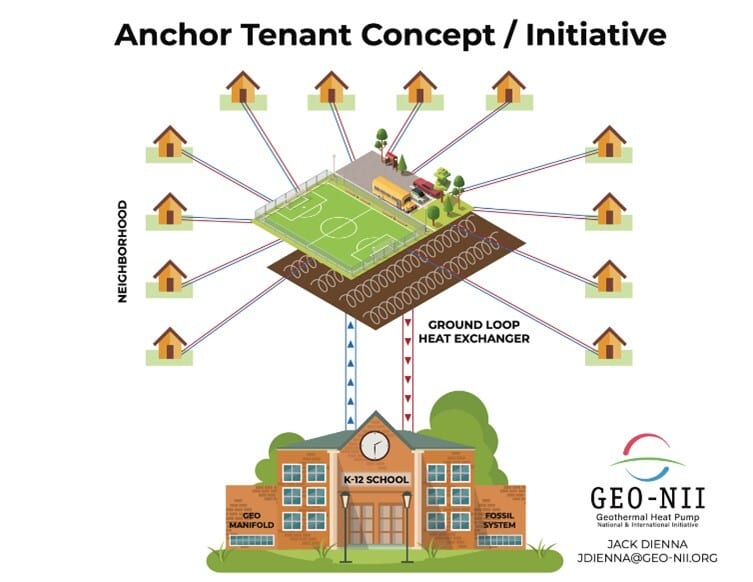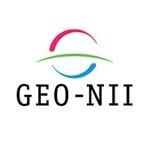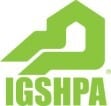
Pre-K to 12 Schools: The “Anchor Tenant” for the Ground Heat Exchanger!
By Jack DiEnna, Executive Director & Founder of the Geothermal National & International Initiative (GEO-NII)
Ground Source / Geothermal Technology is finally being recognized as a valued renewable thermal asset by the US DOE (Consolidated Appropriations Act 2021).
This along with the “Climate Change” narrative should have opened the flood gates for this technology … but it hasn’t. We still must fight the lack of awareness for not only the technology but more important the many benefits these systems bring to the table.
This technology centers on the issue of the energy used in buildings which the US DOE states accounts for over 36% of the primary energy used in the US and 40% of that energy is for space conditioning (heating & cooling) and water heating.
Pre-K to 12 Schools
Pre-K to 12 schools are the second largest public infrastructure investment in the US and are one of the biggest energy consumers in the public sector.
They consume about 8% of all energy used in commercial buildings and emit as much carbon dioxide as 18 coal powered generating plants and spend over $8 billion annually on energy.
There are over 131,000 Public and Private K to 12 schools in the US with over 3.6 million public and private school students in attendance. According to the National Council for School Facilities, the average age of a K to 12 school in the US is 50 years old and 41% of those have failing HVAC systems.
How does this impact the Ground Source / Geothermal Heat Pump Industry?
That 41% amounts to 53,710, all of which have a need for the repair or replacement of their HVAC and a good portion of those have “heating only” systems which according to research done by both Harvard Medical and Yale Medical points to the fact that this may also be a health issue. Those studies state that “higher relative humidity impedes the transmission of respiratory viruses” (read COVID). It has been said that heating only schools have a relative humidity of approximately 10 to 15%. Installing a Ground Source Heat Pump (GSHP) system increases the relative humidity to over 45% which improves the health and safety of both students and staff.
K to 12 Schools as the “Anchor Tenant” for the Ground Loop Heat Exchanger (GLHE).
This initiative, which is a true “Networked” system, takes advantage of a K to 12 School typically having a large open area such as an athletic field, parking lot, etc. that is an ideal location for the ground loop heat exchanger (GLHE), eliminating the need for street closures and traffic disruptions and ease of access to the surrounding homes and businesses in the community.
The “Anchor Tenant” program would also take advantage of the diversity of the system, meaning that the main needs of the school are opposite to those of the surrounding community. This is especially evident in the cooling season, when the school, unless it is “year-round” has minimal use allowing, more cooling available for the surrounding community.
Another reason to embrace the “Anchor Tenant” initiative is that our local schools have grown beyond academic institutions. They have become social gathering places, weekend worship centers, as well as safe havens for our communities’ children and their families.
How would it work?
The system would be designed at 100% capacity for the school, but the loop field may be increased to include any of the surrounding buildings that agree to install a ground source system.


If there is interest from the community, a pumping station could be included in the design to ensure delivery of the ground source technology to the community. This initiative also ensures that the system will have a major client for years to come.
Photo Credit: GTD
What Could This Mean for the Geothermal Industry?
Using square footage of Pre-K to 12 school buildings from the National Council for School Facilities, and assuming 400 sq. ft per ton, a Pre-K to 8 school building at 118,500 sq ft., would equate to 296 tons of GSHPs per school.
High schools at 173,727 sq ft., also assuming 400 sq ft per ton, would add up to 434 tons per school.
The number of Public and Private Pre-K to 8 is 35,785, at 296 tons equates to 10,592,360 tons of capacity.
Public and Private High Schools number 11,122 at 434 tons per school, equates to 6,490,000 tons of capacity.
Given these numbers, it points to the fact that this is a major demographic for the Ground Source / Geothermal industry.
It will mean increased opportunity for the drilling community (400 drilling foot per ton equates to 38,500 - 400 ft. bore holes).
It will have a major impact on the manufacturing community. Based on the assumptions made, the total tonnage is 15,420,000 tons of GSHPs, which would mean that all of the manufacturers would have to increase production by 100 times the amount that is being produced now.
The design community would have to increase the number of Certified Geothermal Designers (CGD) through IGSHPA which is the “gold standard” for designing institutional or commercial ground source systems.
There would be a need for a major increase in training for the IGSHPA accredited installer network as well.
Will this impact the Utility Community?
It most certainly will. A study conducted by Western Farmers Co-Operative in Oklahoma found that every installed ton of GSHP capacity reduced Peak Load by 0.55kW.
Given the total number of installed tons (15,420,000) in the Pre-K to 12 school market, that could result in a peak load reduction of 28 GW using this renewable thermal asset as the catalyst.
This would also result in emission reductions using a non-wire, non-pipeline alternative to support the utilities’ climate mandates and goals.
This initiative could also become a rate based new business opportunity for utilties in the ownership of the ground loop heat exchanger.
How can I participate?
If you are reading this article and you live in a community, chances are that some of your schools are in the 50-year-old category. Get involved, go to the school board meetings, inform them that your industry has an answer to a better learning environment and healthier schools.
If there is an opportunity, let IGSHPA know through the website (https://igshpa.org). We can put together an informational package for the school board or offer advice, but it all starts with you, the IGSHPA member.
In Summary!
By using K to 12 schools as the “Anchor” for a Network ground source system, it not only promotes a better learning environment but serves as an educational and solid marketing tool for the residential market. It gives us 25 “geo promoters” in each classroom.
Lastly, it supports a safer and healthier learning environment for our greatest assets….Our Kids!
Remember GSHP technology is not only revolutionary, but also Evolutionary!
Jack DiEnna, Executive Director & Founder of the Geothermal National & International Initiative (GEO-NII). Originator of the “Anchor Tenant” concept for networked geothermal systems installing the ground loop heat exchanger in K to 12 schools’ fields, parking lots, etc. Appointed US Department of Energy’s Geothermal Visionary team. Member of the American/Canadian Bi National GHP Standards Committee. Founding Member of the New York Geo Association and the Pennsylvania Geothermal Association.




